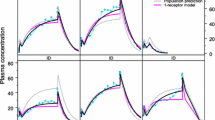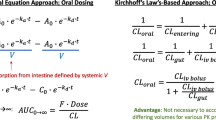Abstract
Pharmacokinetic (PK) models simplify biological complexity by dividing the body into interconnected compartments. The time course of the chemical′s amount (or concentration) in each compartment is then expressed as a system of ordinary differential equations. The complexity of the resulting system of equations can rapidly increase if a precise description of the organism is needed. However, difficulties arise when the PK model contains more variables and parameters than comfortable for mathematical and computational treatment. To overcome such difficulties, mathematical lumping methods are new and powerful tools. Such methods aim at reducing a differential system by aggregating several variables into one. Typically, the lumped model is still a differential equation system, whose variables are interpretable in terms of variables of the original system. In practice, the reduced model is usually required to satisfy some constraints. For example, it may be necessary to keep state variables of interest for prediction unlumped. To accommodate such constraints, constrained lumping methods have are also available. After presenting the theory, we study, here, through practical examples, the potential of such methods in toxico/pharmacokinetics. As a tutorial, we first simplify a 2-compartment pharmacokinetic model by symbolic lumping. We then explore the reduction of a 6-compartment physiologically based pharmacokinetic model for 1,3-butadiene with numerical constrained lumping. The lumping methods presented here can be easily automated, and are applicable to first-order ordinary differential equation systems
Similar content being viewed by others
References
Gibaldi M., Perrier D. Pharmacokinetics. Second Edition, revised and expanded ed., Marcel Dekker, New York, 1982.
J.E. Dennison M.E. Andersen R.S.H. Yang (2003) ArticleTitleCharacterization of the pharmacokinetics of gasoline using PBPK modeling with a complex mixtures chemical lumping approach Inhal. Toxicol 15 IssueID10 961–986 Occurrence Handle12928975 Occurrence Handle1:CAS:528:DC%2BD3sXmslCls7Y%3D
J.E. Dennison M.E. Andersen I.D. Dobrev M.M. Mumtaz R.S.H. Yang (2004) ArticleTitlePBPK modeling of complex hydrocarbon mixtures: Gasoline Environ. Toxicol. Pharmacol 16 IssueID1–2 107–119 Occurrence Handle1:CAS:528:DC%2BD2cXhslWltLg%3D
I.A. Nestorov L.J. Aarons P.A. Arundel M. Rowland (1998) ArticleTitleLumping of whole-body physiologically based pharmacokinetic models J. Pharmacokinet. Biopharm 26 21–46 Occurrence Handle9773391 Occurrence Handle1:CAS:528:DyaK1cXmsVGqu7s%3D
S. Bjorkman (2003) ArticleTitleReduction and lumping of physiologically based pharmacokinetic models: Prediction of the disposition of fentanyl and pethidine in humans by successively simplified models J. Pharmacokinet. Pharmacodyn 30 IssueID4 285–307 Occurrence Handle14650375
G. Li H. Rabitz (1989) ArticleTitleA general analysis of exact lumping in chemical kinetics Chem. Eng. Sci 44 IssueID6 1413–1430 Occurrence Handle1:CAS:528:DyaL1MXkt1Gltbs%3D
G. Li H. Rabitz (1990) ArticleTitleA general analysis of approximate lumping in chemical kinetics Chem. Eng. Sci 45 IssueID4 977–1002 Occurrence Handle1:CAS:528:DyaK3cXit1ChtLk%3D
G.Y. Li A.S. Tomlin H. Rabitz J. Toth (1994) ArticleTitleA general analysis of approximate nonlinear lumping in chemical kinetics II Unconstrained lumping J. Chem. Phy 101 IssueID2 1172–1187 Occurrence Handle10.1063/1.467811 Occurrence Handle1:CAS:528:DyaK2cXltFyltrw%3D
G. Li H. Rabitz J. Toth (1994) ArticleTitleA general analysis of exact nonlinear lumping in chemical kinetics Chem. Eng. Sci 49 IssueID3 343–361
J. Wei J.C.W. Kuo (1969) ArticleTitleA lumping analysis in monomolecular reaction systems Analysis of the exactly lumpable system. Ind. Eng. Chem. Fundam 8 114–123 Occurrence Handle1:CAS:528:DyaF1MXotFelsg%3D%3D
G. Li H. Rabitz (1993) ArticleTitleThe direct lumping approach: An application to a catalytic reforming model Chem. Eng. Sci 48 IssueID10 1903–1909 Occurrence Handle1:CAS:528:DyaK3sXitlKrtrw%3D
A.S. Tomlin T. Turanyi M.J. Pilling (1997) Mathematical Tools for the Construction, Investigation and Reduction of Combustion Mechanisms M.J Pilling (Eds) Low-temperature Combustion and Autoignition. Elsevier Amsterdam 293–437
H.J. Verhaar J.R. Morroni K.F. Reardon S.M. Hays D.P. Gaver SuffixJr. R.L. Carpenter R.S. Yang (1997) ArticleTitleA proposed approach to study the toxicology of complex mixtures of petroleum products: The integrated use of QSAR, lumping analysis and PBPK/PD modeling Environ. Health. Perspect 105 IssueIDSuppl 1 179–195 Occurrence Handle9114286 Occurrence Handle1:CAS:528:DyaK2sXktVCnsbs%3D
S.W. Wang P.G. Georgopoulos G. Li H. Rabitz (1998) ArticleTitleCondensing complex atmospheric chemistry mechanisms. 1. The direct constrained approximate lumping (DCAL) method applied to alkane photochemistry Environ. Sci. Technol 32 IssueID13 2018–2024 Occurrence Handle1:CAS:528:DyaK1cXjt1Ghtr4%3D
G. Li H. Rabitz (1991) ArticleTitleNew approaches to determination of constrained lumping schemes for a reaction system in the whole composition space Chem. Eng. Sci 46 IssueID1 95–111 Occurrence Handle1:CAS:528:DyaK3MXksFygsQ%3D%3D
G. Li H. Rabitz (1991) ArticleTitleDetermination of constrained lumping schemes for nonisothermal first-order reaction systems Chem. Eng. Sci 46 IssueID2 583–596 Occurrence Handle1:CAS:528:DyaK3MXosVKmtw%3D%3D
J.A. Jacquez C.P. Simon (1993) ArticleTitleQualitative theory of compartmental systems Siam Rev 35 43–79 Occurrence Handle10.1137/1035003
F.Y. Bois T.J. Smith A. Gelman H.Y. Chang A.E. Smith (1999) ArticleTitleOptimal design for a study of butadiene toxicokinetics in humans Toxicol. Sci 49 IssueID2 213–224 Occurrence Handle10.1093/toxsci/49.2.213 Occurrence Handle10416266 Occurrence Handle1:CAS:528:DyaK1MXkt1yqurc%3D
M. Mezzetti J.G. Ibrahim F.Y. Bois L.M. Ryan L. Ngo T.J. Smith (2003) ArticleTitleA Bayesian compartmental model for the evaluation of 1,3-butadiene metabolism J. Roy. Stat. Soc. C-App. Stat. 52 291–305
M.C. Kohn R.L. Melnick (1993) ArticleTitleSpecies differences in the production and clearance of 1,3-butadiene metabolites: a mechanistic model indicates predominantly physiological, not biochemical, control Carcinogenesis 14 619–628 Occurrence Handle8472325 Occurrence Handle1:CAS:528:DyaK3sXisV2lu78%3D
Smith T., Lin Y.-S., Mezzetti L., Bois F.Y., Kelsey K., Ibrahim J. Genetic and dietary factors affecting human metabolism of 1,3-butadiene. Chem. Biol. Interact 135–136:407–428 (2001).
A. Gelman F.Y. Bois J. Jiang (1996) ArticleTitlePhysiological pharmacokinetic analysis using population modeling and informative prior distributions J. Am. Stat. Assoc 91 IssueID436 1400–1412
G. Li H. Rabitz (1991) ArticleTitleA general lumping analysis of a reaction system coupled with diffusion Chem. Eng. Sci 46 IssueID8 2041–2053 Occurrence Handle1:CAS:528:DyaK3MXktlWru7o%3D
G. Li H. Rabitz (1997) ArticleTitleReduced kinetic equations of a CO/H2/air oxidation model by a special perturbation method Chem. Eng. Sci 52 IssueID23 4317–4327 Occurrence Handle1:CAS:528:DyaK1cXjvVWjsA%3D%3D
R. Bellman (1960) Introduction to Matrix Analysis McGraw-Hill Book Company Inc. New York, Toronto, London
Author information
Authors and Affiliations
Corresponding author
Rights and permissions
About this article
Cite this article
Brochot, C., Tóth, J. & Bois, F.Y. Lumping in Pharmacokinetics. J Pharmacokinet Pharmacodyn 32, 719–736 (2005). https://doi.org/10.1007/s10928-005-0054-y
Received:
Accepted:
Issue Date:
DOI: https://doi.org/10.1007/s10928-005-0054-y




